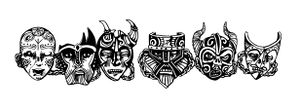Template:Front/featured: Difference between revisions
mNo edit summary |
Chrysophylax (talk | contribs) mNo edit summary |
||
| Line 1: | Line 1: | ||
'''[[ | '''[[Brooding|Brooding]]''' is a language spoken in the land of Harken, purportedly created at the dawning of the Last Age by Clyde P. Riddlesbrood. Brooding was created by Scott L. Hamilton for the Riddlesbrood Touring Theater Company based on elements developed by the theater’s director Ryan Long. In the fall of 2014, development and curatorship of the language was assumed by [[User:Bpnjohnson|BenJamin P. Johnson]]. | ||
The standard word order is | The standard word order is subject-verb-object (SVO), somewhere in the middle of the synthetic-isolating scale, with obligatory V2 word order. The Brooding syllable is maximally CCVCC and minimally V. | ||
[[File:Brooding-gate1.jpg|thumbnail|Floating heads: ''gedreen e doon/wis'']] | |||
[[File:Brooding-gate2.jpg|thumbnail|Masques: ''gedreen e doon/wis'']] | |||
In addition to a latinisation, Brooding also uses a writing system comprised of two sets of characters: seeing characters and blind characters. Seeing characters form an alphabet, with each seeing character representing a Brooding sound. The blind characters are logograms used in various ways. | |||
These “faces” (called gawbren) may be used in various props, illustrations, or even mimicked by actors to tell a “story within a story.” The angle of the head may also be manipulated to create dual meanings. On the left are two examples of a clue which could mean “Gate of Faces” (gedreen e doon) or “Gate of Dreams” (gedreen e wis). | |||
<noinclude>[[Category:Templates]][[Category:Main page]][[Category:Meta]]</noinclude> | <noinclude>[[Category:Templates]][[Category:Main page]][[Category:Meta]]</noinclude> | ||
Revision as of 17:03, 17 August 2016
Brooding is a language spoken in the land of Harken, purportedly created at the dawning of the Last Age by Clyde P. Riddlesbrood. Brooding was created by Scott L. Hamilton for the Riddlesbrood Touring Theater Company based on elements developed by the theater’s director Ryan Long. In the fall of 2014, development and curatorship of the language was assumed by BenJamin P. Johnson.
The standard word order is subject-verb-object (SVO), somewhere in the middle of the synthetic-isolating scale, with obligatory V2 word order. The Brooding syllable is maximally CCVCC and minimally V.
In addition to a latinisation, Brooding also uses a writing system comprised of two sets of characters: seeing characters and blind characters. Seeing characters form an alphabet, with each seeing character representing a Brooding sound. The blind characters are logograms used in various ways. These “faces” (called gawbren) may be used in various props, illustrations, or even mimicked by actors to tell a “story within a story.” The angle of the head may also be manipulated to create dual meanings. On the left are two examples of a clue which could mean “Gate of Faces” (gedreen e doon) or “Gate of Dreams” (gedreen e wis).

